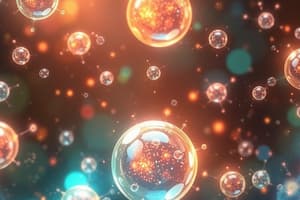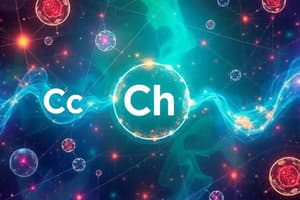Podcast
Questions and Answers
What type of reaction involves the exchange of ions between two compounds?
What type of reaction involves the exchange of ions between two compounds?
- Double replacement (correct)
- Decomposition
- Single replacement
- Synthesis
What is described by the equilibrium constant (K) in a chemical reaction?
What is described by the equilibrium constant (K) in a chemical reaction?
- The ratio of products to reactants at equilibrium (correct)
- The speed of the forward reaction only
- The pH level of the solution
- The total energy absorbed during the reaction
What measurement indicates the acidity or basicity of a solution?
What measurement indicates the acidity or basicity of a solution?
- pH scale (correct)
- Viscosity
- Density
- Molality
Which phase change occurs when a substance transitions from solid directly to gas?
Which phase change occurs when a substance transitions from solid directly to gas?
What is the primary focus of nuclear chemistry?
What is the primary focus of nuclear chemistry?
What defines matter in scientific terms?
What defines matter in scientific terms?
Which state of matter has a definite shape and volume?
Which state of matter has a definite shape and volume?
What type of bond involves the sharing of electrons?
What type of bond involves the sharing of electrons?
Which describes the substances that undergo change in a chemical reaction?
Which describes the substances that undergo change in a chemical reaction?
Which of the following describes a physical property of matter?
Which of the following describes a physical property of matter?
How are elements organized on the periodic table?
How are elements organized on the periodic table?
What type of bond typically forms between a metal and a nonmetal?
What type of bond typically forms between a metal and a nonmetal?
What changes characterize chemical reactions?
What changes characterize chemical reactions?
Flashcards
Stoichiometry
Stoichiometry
The quantitative relationship between reactants and products in a chemical reaction. It involves calculations related to mass, moles, and volumes of reactants and products.
Phase Changes
Phase Changes
The change from one state of matter (solid, liquid, gas) to another due to energy absorption or release.
Acids
Acids
Substances that release hydrogen ions (H+) when dissolved in water. They have a pH less than 7.
Bases
Bases
Signup and view all the flashcards
Chemical Equilibrium
Chemical Equilibrium
Signup and view all the flashcards
What is chemistry?
What is chemistry?
Signup and view all the flashcards
Define matter.
Define matter.
Signup and view all the flashcards
What is an atom?
What is an atom?
Signup and view all the flashcards
What is an element?
What is an element?
Signup and view all the flashcards
Define a compound.
Define a compound.
Signup and view all the flashcards
What is a chemical bond?
What is a chemical bond?
Signup and view all the flashcards
Define a chemical reaction.
Define a chemical reaction.
Signup and view all the flashcards
What is a reactant?
What is a reactant?
Signup and view all the flashcards
Study Notes
Introduction to Chemistry
- Chemistry is the scientific study of matter, its properties, composition, and reactions.
- It encompasses the behavior and interaction of atoms and molecules.
- It's a fundamental science that underpins many other scientific disciplines like biology, physics, and engineering.
Matter and its Properties
- Matter is anything that occupies space and has mass.
- Matter exists in three primary states: solid, liquid, and gas.
- Solid matter has a definite shape and volume.
- Liquid matter has a definite volume but takes the shape of its container.
- Gaseous matter has neither a definite shape nor a definite volume.
- Properties of matter can be classified as physical or chemical.
- Physical properties can be observed without changing the substance's composition (e.g., color, boiling point, melting point).
- Chemical properties describe how a substance reacts with other substances (e.g., flammability, reactivity with acids).
Atoms and Molecules
- Atoms are the basic building blocks of matter.
- Atoms consist of a nucleus containing protons and neutrons, surrounded by electrons.
- Elements are pure substances composed of only one type of atom.
- Molecules are formed when two or more atoms bond together.
- Compounds are pure substances composed of two or more different elements chemically combined.
Elements
- Organized on the periodic table based on their atomic structure and properties.
- The periodic table arranges elements by atomic number (number of protons), allowing for prediction of properties based on location.
- Elements are classified as metals, nonmetals, or metalloids based on their properties.
Chemical Bonds
- Bonds are forces that hold atoms together in molecules and compounds.
- Types of chemical bonds include ionic bonds (transfer of electrons), covalent bonds (sharing of electrons), and metallic bonds (delocalized electrons).
- Ionic bonds typically form between metals and nonmetals.
- Covalent bonds typically form between nonmetals.
- Metallic bonds are characteristic of metals.
Chemical Reactions
- Chemical reactions involve the rearrangement of atoms to form new substances.
- Reactants are the substances that undergo change.
- Products are the new substances formed.
- Chemical equations describe the reactants and products involved in a reaction.
- Chemical reactions are characterized by changes in energy (heat absorption or release).
- Types of reactions include synthesis, decomposition, single replacement, double replacement, and combustion.
Stoichiometry
- Stoichiometry is the quantitative relationship between reactants and products in a chemical reaction.
- Calculations related to mass, moles, and volumes of reactants and products are part of stoichiometry.
- This is essential for understanding and predicting chemical reactions in various applications.
States of Matter and Phase Changes
- The states of matter (solid, liquid, gas) change due to energy absorption or release causing phase changes (melting, freezing, vaporization, condensation, sublimation).
Acids and Bases
- Acids are substances that release hydrogen ions (H+) in water.
- Bases are substances that release hydroxide ions (OH-) in water.
- pH scales measure the acidity or basicity of a solution.
Solutions
- A solution is formed when a solute dissolves in a solvent.
- The concentration of a solution describes the amount of solute dissolved in a given amount of solvent.
Equilibrium
- Chemical equilibrium is a state where the rates of forward and reverse reactions are equal, leading to a constant concentration of reactants and products.
- Equilibrium constant (K) quantifies the ratio of products to reactants at equilibrium.
Thermodynamics
- Thermodynamics deals with the relationship between heat, work, and energy changes in chemical and physical processes.
- Laws of thermodynamics govern these changes.
Nuclear Chemistry
- Nuclear chemistry focuses on reactions within the nucleus of an atom.
- Radioactivity involves the spontaneous emission of radiation from unstable nuclei.
- Nuclear reactions can be harnessed for various applications, such as nuclear power and medical imaging.
Studying That Suits You
Use AI to generate personalized quizzes and flashcards to suit your learning preferences.




